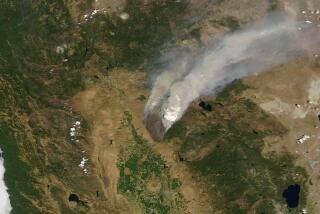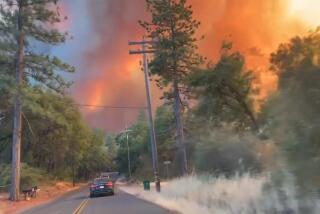Griffith Park was the scene of the deadliest fire in state history. The Butte County disaster has surpassed it
At 42 dead and counting, the Camp fire in Butte County has surpassed the previous deadliest fire in state history: a 47-acre scorcher that killed 29 people in Los Angeles’ Griffith Park in 1933, according to the California Department of Forestry and Fire Protection.
Officials expect the death toll to rise in Butte, noting that 200 people are still reported missing.
Here’s some background on the earlier fire from the pages of The Times:
More than 3,700 Works Progress Administration and Civilian Conservation Corps workers were maintaining bridle trails, pulling weeds and building roads that visitors use today.
The Depression-era New Deal programs, which provided work for the jobless, were meant to give hope to President Franklin D. Roosevelt’s “forgotten man.”
A little after 2 p.m. on Oct. 3, a blaze began in a small pile of leaves near the parking lot of the golf course clubhouse. A careless smoker might have been responsible; a man in a dark suit was seen running away but never identified.
Bernard Mack, 19, a high school dropout from Boyle Heights, was clearing a road when his supervisor ordered his WPA crew to fight the fire.
“We were kibitzing about the upcoming USC football game,” Mack recalled in 2004 interview with The Times. “[We] didn’t think it was that big a deal as we threw buckets of sand on the fire.”
“Smack it out with your shovels and cut a firebreak!” one of the supervisors yelled. Most of the men and supervisors had little or no firefighting experience. Some workers said their bosses had threatened to revoke their work permits if they hesitated.
As the fire started moving faster, foremen flooded the canyon with workers and set a few backfires in hopes of blocking the original blaze. Those were the worst things they could have done, then-Fire Chief Ralph Scott said. They didn’t know how or where to set the fires, and the canyon was the most dangerous place to be.
When Los Angeles City Fire Engine Company 56 arrived, the professionals found it impossible to control more than 3,000 inexperienced workers. While most firefighters stationed themselves on higher ground, WPA and CCC supervisors kept sending their men into the ravine. A city fire captain stood at the bottom of the canyon, sending them back up as fast as they could go.
“Get out of here, you fellows!” he bellowed. “There’s some wind.”
John Loa was working on a road with the CCC when he and six others were called to help put out the fire with their shovels.
“I remember that our shoes and pants caught on fire, too,” Loa told The Times in 2004. “So we had to extinguish them as well as the brush fire at the same time.”
By 3 p.m. the breeze had shifted, ushering in hell.
“The wind came up all of a sudden,” said Mack, the WPA worker. “I had this fear and started to climb back up the slope. My foreman yelled at me to get back down there, but I kept climbing up anyway, eventually all the way home. And I never returned to work, either.”
Those who hesitated were lost. With the fire roaring like a locomotive, terrified workers clawed up the sides of the canyon as flames licked their heels.
From the ridge, a few thousand workers and firefighters watched in horror as other workers stumbled and pushed their way upward ahead of the fire. Some crawled on their bellies, clinging to the undergrowth, as others walked over them.
“Most of us got out in time,” survivor Leo McCormick said in a 1933 interview. He burned his left arm pulling someone to safety.
“The horrible cries of those caught by the flames echoed through the canyon,” McCormick said. “We had to hold our hands to our ears to drown out the terrible sound.”
One man could be heard crying out, “My God, my family.”
Miguel Holquin survived by jumping into a stone planter that surrounded an oak tree and throwing sand over himself. Others jumped into the swimming pool at the Girls Camp.
“We were working down in the ravine when my crew chief called out to us, saying, ‘You don’t belong to that [work] gang, get back up here,’ ” he said. “When we changed locations, the wind shifted and our lives were spared. Later we learned that the other crews we had been working beside had been trapped and had lost their lives.”
By nightfall, firefighters and workers had confined the blaze to 47 acres. Twenty-nine charred bodies were recovered — all facing the same direction, their arms outstretched toward the safety of the summit.
“Two of the bodies lay with hands joined together,” McCormick said. “One was a young man. The other apparently was older. The body of the younger man was a little higher on the side of the canyon than that of his companion. Evidently he had endeavored to assist his more aged fellow worker to safety and had perished in the attempt.”
“Death rode a twisting wind into a canyon of Griffith Park,” The Times reported.
“ ‘Smack it out with your shovels and cut a fire break!’ was the order ringing in the ears of the more than 1,500 men, all of them unskilled at brush fire fighting, as they entered the peaceful canyon which was soon to become a hissing, crackling death scene for some of their number,” the newspaper said.
Track key details of the California wildfires »
A month after the disaster, a plaque honoring the victims was placed by the Los Feliz Women’s Club near the park’s Vermont Avenue entrance. It eventually disappeared.
A bronze sculpture commissioned by the Works Progress Administration to honor Conservation Corps workers was dedicated by Roosevelt in 1935. It was destroyed in a flood three years later.
Finally, in 2007, the city honored the victims again with a tree planting that included a survivor from that day.
More to Read
Sign up for Essential California
The most important California stories and recommendations in your inbox every morning.
You may occasionally receive promotional content from the Los Angeles Times.










